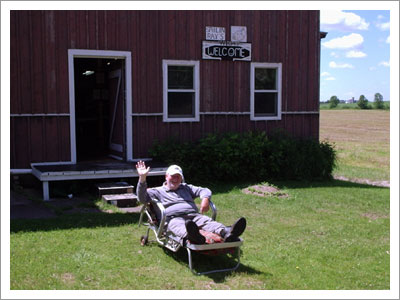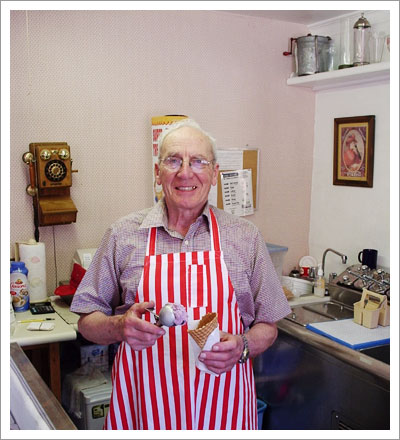Do you think of yourself as a Midwesterner? A Northerner? If you live in Chicago, author Ted McClelland would call you a Great Laker. McClelland spent last summer driving around the Great Lakes — a 9,600-mile trip that took him as far west as Duluth, Minnesota, and as far east as Kingston, Ontario — to research his upcoming book, The Third Coast, which looks at the Lakes as a distinct region of North America, with its own culture and common interests. Gapers Block is pleased to present a series of excerpts from the book over the next several months.
Sheboygan County, Wisconsin
There are two rules for driving clockwise around the Great Lakes: always keep the water on your right, and stick to the road closest to the beach. They are good rules. On the second day of my trip, they led me to the Haven Hi Guy. I was headed out of Sheboygan on County Road LS (for Lake Shore). A mile or two south of Haven, I began seeing signs for Whistling Straits. It sounded like a picturesque lake scene, a visual keepsake to lock into my digital camera, so I followed along. I was still looking for the straits when I puttered through Haven, a T-intersection consisting of two or three houses and a shuttered filling station. As I passed by an old barn, its red paint weathered to russet, its wooden door painted with a white 'Z,' a soft-bellied man in a lawn chair raised his arm to hail my passing. He wore a golf cap and a patchy, chalk-colored beard that nearly blended into his Nordic-pale face. People don't wave in this part of the country, even on roads where the cars are spaced like numbers on a clock. Encouraged by his greeting, I stopped to ask for directions.
"I'm looking for Whistling Straits."
"Whistling Straits? It's just at the end of this road."
There were two signs nailed to the barn behind him: the top read SMILIN' RAY, the bottom his rural street number, W1043, and the world WELCOME, with dot eyes and a crescent grin drawn inside the 'O.' I peered through the screen door. Dimly, I could see posters, and picture frames, and long wooden magazine bins, shaped like the lower halves of pinball machines.

"What's in your building?" I asked.
"Oh..." He seemed bashful about the enterprise, even though it was advertised to the road. "Comic books. Movie stuff. I've got a golf museum, too."
It turned out that Whistling Straits was a golf course. The Kohler Company, which is famous for its sinks and toilets, owns the Old Course Hotel at St. Andrew's, the birthplace of golf, and they are trying to duplicate it in Wisconsin. They hired a renowned landscaper to gouge and plump the Lake Michigan shoreline into a replica of a Scottish firth — a windy, sandy place where stone-sized golf balls could be swept out to the water — and they'd linked the course to a tony spa, The American Club, "the Midwest's only AAA Five Diamond Resort Hotel." At $275 a round ($325 if you require a caddy) Whistling Straits is exclusive. As a result, Haven is consistently buzzed by private planes, carrying members of the corporate peerage who can't stand to be excluded from anything. It's a big-game golf course. The PGA Championship was held there in 2004. That's when Ray Olbrantz, the shy man who waved at my car, became the Haven Hi Guy.
Ray led me into his barn. There wasn't much light, and the long planks underfoot made every step echo with import. It felt like the inside of an old farm museum. But Star Wars action figures stood on the shelves, and there were banks of old comics, sealed in transparent plastic sleeves. A poster from the Shaquille O'Neal movie Kazaam adorned a wooden wall. All of this had been imported from Milwaukee. After retiring as a printer, Ray had run a comic book store there. One day, he was mowing his lawn when a man walked up and offered to buy his house. Ray had always wanted to live Up North, so he accepted the offer and used the money to move his family — and his comic books — to Haven.
The centerpiece of the room was the golf museum. Balanced on a plastic grid, like eggs in their trays, were 1,200 balls Ray had collected during his spring and fall walks on the course. They were painted with the logos of some of the world's wealthiest corporations — ING, Bank of America, Aon — and its grandest golf courses — Medinah, Troon North. Ray couldn't afford the greens fees at Whistling Straits, but sometimes, he hit duplicate balls around his yard.
There was only one road in and out of Whistling Straits, and it went past Smilin' Ray's. When Ray heard the PGA Championship was coming to his village, he had a dream.
"I had dreamed about six months before that I would meet Tiger Woods," he said. "I figured, 'How's a little guy like me going to meet Tiger Woods?' I couldn't even afford to go to the course."
The tournament began on a Thursday. Early that morning, Ray set up his lawn chair, and waited for the caravan. Limos drove past, and glossy Cadillac Escalade SUVs. Ray waved at every one. At first, a few of the passengers waved back. But by the weekend, the guy in the lawn chair had become a tournament celebrity. Japanese champion Kadayama Shingo pulled up in an SUV filled with six golfers, and gave Ray an autographed program. Ben Crane proffered a ticket to the Wannamaker Club, the course's VIP lounge.
"Almost every member of the PGA stopped here and shook my hand, from the president on down," Ray said. "Some old guy came up on Sunday and said, 'Put this in your collection.'"
Ray handed me a PGA Past President's badge, mounted on a plastic-coated metal clip that clapped over a breast pocket."How could you sell something like that?" he wondered. "I wouldn't sell it, unless things got critical. He saw something in me that made him want to give it to me."
That same morning, a Buick SUV rolled up the dirt driveway. Tiger Woods's caddy stepped out and handed Ray a practice round map, signed by Tiger himself. Through the truck's open window, Ray saw the man he'd dreamed about. He wasn't going to miss his chance. He reached inside, and shook Tiger Woods's hand.
That map was now preserved in a glass frame, hung on a pillar. So was this letter from the PGA president: "The memories we all have of the beautiful setting near Lake Michigan, the excellent golf course and the wonderful fans will never fade," he had written. "You know what also won't be forgotten? Your enthusiasm for the thousands of strangers that passed by your doorstep on the way to the Championship." Beneath it was a proclamation from the governor of Wisconsin, declaring Ray the "Haven Hi Guy."
"Oh, that was something they came up with," Ray protested, as I read the governor's thank-you note to the man who 'smiled and waved at every car, bus, service vehicle, limousine, motorcycle, and skateboard that passed by.' "I never called myself that."
I can't imagine Ray Olbrantz sold many comic books or action figures in Haven. Certainly not as many as he may have in Milwaukee. Anyone who can afford to golf at Whistling Straits doesn't need a fantasy life. But he'd distinguished himself on his rural road in a way that would have been impossible in the city. If Ray had waved at the traffic from the sidewalk of Milwaukee store, he would have looked like a street person. In Haven, he looked folksy.
"It's the only thing that gets people to stop once in awhile," he said.
It worked on millionaire golfers and wayfaring writers alike, although Tiger Woods didn't buy anything, and neither did I. He was in a hurry, and I was traveling on an advance from a publisher who takes pains to tell his authors they should write for love, not money.
After I left Smilin' Ray's, I followed his road to Whistling Straits. Beyond the gates was a long, manorial driveway that knotted itself into a loop in front of a dramatic stone clubhouse. SUVs idled at the curb, and caddies in white parachute jumpsuits waited for bags. The lake was nearby. The air smelled fresh as snapping laundry, and the blue-screen sky above the clubhouse was chalked with jet-trail clouds. But from where I was parked, I couldn't see the water. For that, you had to pay admission.
Manitowoc County, Wisconsin
My last stop before Door County was Two Rivers, birthplace of the ice cream sundae. Unlike Danish kringle and fried cheese curds, the ice cream sundae is a Wisconsin delicacy that made it big. You can eat one anywhere, any day of the week. Ordinarily, I advise readers to avoid small towns that bill themselves as "historic." That usually means there's nothing going on there nowadays. But the nativity scene of the sundae is recreated at a parlor in the Washington House Hotel, on a side street a block from the town square.
Two Rivers isn't the only town to call itself "Birthplace of the Ice Cream Sundae." Ithaca, New York, and Evanston, Illinois, make the same claim. All three creation legends are similar, but Two Rivers' is the oldest. In the 19th Century, the story goes, puritanical town elders across the North banned soda pop on Sundays. The fizzy drink was considered too racy for the Sabbath. One Sunday afternoon in 1881, a man named George Hallauer walked into a soda fountain owned by Edward C. Berner and asked him to top a dish of ice cream with that sauce he used for chocolate sodas. It tasted so good Berner started selling the dish for a nickel, but only on Sundays. Then, according to the plaque that occupies a space on the wall next to the soda jerk's old derby, "a ten-year-old girl insisted she have a dish of ice cream 'with that stuff on top,' saying they could 'pretend it was Sunday.'"
The parlor was meant to evoke the decade we used to call the Gay Nineties, before another, gayer Nineties intervened. The dainty chairs were backed with wires twisted into butterfly wings, a crank telephone waited for calls last dialed in 1911, and against the pinkish wallpaper was a photo of Berner, a spruce young buck sporting a topcoat and smoking a stogie. In the corner, a white-haired man in a peppermint-striped apron was bent behind a glass case, scooping ice cream.

"What's the most popular topping?" I asked.
"Hot fudge."
"OK. I'll have hot fudge."
"Do you want nuts?"
"Of course. Can I get a cherry, too?"
"It wouldn't be a sundae without a cherry."
He handed me my ice cream, already melting in its long-stemmed glass dish.
"Tuna quarter," he said.
That's not another Wisconsin treat. That's Ya Hey pricing. I paid him two dollars and twenty-five cents.
Read on:
1. Sheboygan & Manitowoc County, Wisconsin
2. Marquette, Michigan
3. Mackinac Island, Michigan
4. Grand Marais, Minnesota
5. Pays Plat First Nations Reserve, Ontario, Canada
6. Isle Royale, Michigan
7. Rogers City, Michigan
8. Toronto, Canada
9. Hamilton, Ontario
10. Hamburg, New York
Buy the book.





